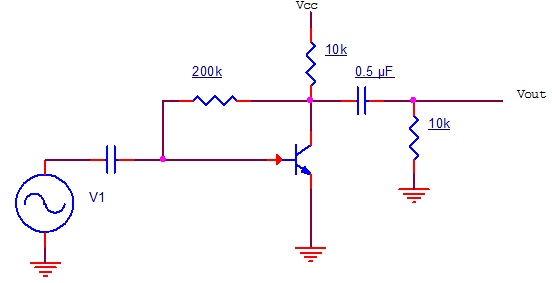1. Given collector resistance = 2kΩ, load resistance = 5kΩ, collector capacitance = 1μF, emitter capacitance = 20μF, collector current = 2mA, source resistance = 2kΩ. If the effect of blocking capacitor is ignored, find the applicable cut-off frequency.
a) 22.73 Hz
b) 612 Hz
c) 673Hz
d) 317 Hz
Explanation: RC = 2kΩ, RL = 5kΩ, CC = 1μF, CB = 10μF, CE = 20μF, RS = 2 kΩ
hie = 1kΩ, IC = 2mA
fL1 = 1/2πCC(RC+RL) = 22.73 Hz
fL2 = gm/2πCE = IC/2πCEVT = 612 Hz
Since fL2 > 4fL1, hence fL2 is the correct answer
2. Consider the circuit shown.
hfe = 50, hie = 1000Ω. Find magnitude of voltage gain at input frequency 10Hz.
a) 100
b) 133
c) 166
d) 220
Explanation: Net load = 10k||10k = 5kΩ = RL’
AVM = -hfeRL’/hie = -50×5/1 = -250
fL = 1/2πCC(RC+RL) = 15.9 Hz
AVL = \(\frac{AVM}{\sqrt{1}} + (\frac{fL}{f})^2\) = 133
3. What is the phase shift in RC coupled CE amplifier at lower 3dB frequency?
a) 180°
b) 225°
c) 270°
d) 100°
Explanation: Total phase shift = 180°+ tan-1(fL/f)
At 3dB frequency fL/f = 1
Total phase shift = 180° + 45° = 225°.
4. Consider that the phase shift of an RC coupled CE amplifier is 260°. Find the low frequency gain when the voltage gain of the transistor is -150.
a) 100
b) 26
c) 40
d) 55
Explanation: 180° + tan-1(fL/f) = 260°
fL/f = tan(80) = 5.67
A = \(\frac{150}{\sqrt{1}}\) + 5.672 = 26.05.
5. We cannot use h-parameter model in high frequency analysis because ____________
a) They all can be ignored for high frequencies
b) Junction capacitances are not included in it
c) Junction capacitances have to be included in it
d) AC analysis is difficult for high frequency using it
Explanation: The effect of smaller capacitors is considerable in high frequency analysis of analog circuits, and hence they cannot be ignored. Instead of h-parameter model, we use π-model.
6. Consider a CE circuit, where trans-conductance is 50mΩ-1, diffusion capacitance is 100 pF, transition capacitance is 3 pF. IB = 20μA. Given base emitter dynamic resistance, rbe = 1000 Ω, input VI is 20*sin(107t). What is the short circuit current gain?
a) 30
b) 35
c) 40
d) 100
Explanation: AI = IL/IB
IL = -gmVb’e
Vb’e = Ib rb’e/(1+jωCrb’e)
C = CD + CT = 103pF
Vb’e = 20μ.1k/(1+j.107.103.10-12.1000)
AI = IL/IB = 50m.1k/(1+j.107.103.10-12.1000)
AI = 35 (approx).
7. Given that transition capacitance is 5 pico F and diffusion capacitance is 80 pico F, and base emitter dynamic resistance is 1500 Ω, find the β cut-off frequency.
a) 7.8 x 106 rad/s
b) 8.0 x 106 rad/s
c) 49.2 x 106 rad/s
d) 22.7 x 106 rad/s
Explanation: The frequency in radians is calculated by
ωβ = 1/C.rbe
ωβ = 7.8 x 106.
8. For given BJT, β=200. The applied input frequency is 20 Mhz and net internal capacitance is 100 pF. What is the CE short circuit current gain at β cut-off frequency?
a) 200
b) 100
c) 141.42
d) 440.2
Explanation: The current gain for the CE circuit is A = \(\frac{β}{\sqrt{1+(\frac{f}{f_β})^2}}\)
At f = fβ, A = \(\frac{β}{\sqrt{2}}\)
Hence A = 141.42.
9. Given that β=200, input frequency is f = 20Mhz and short circuit current gain is A = 100. What is the unity gain frequency?
a) 2308 Mhz
b) 2000 Mhz
c) 2508 Mhz
d) 3000 Mhz
Explanation: A = \(\frac{β}{\sqrt{1+(20Mhz/fβ)^2}}\)
1 + (20/f)2 = 4
20/f = 1.732
fβ = 11.54 Mhz
Unity gain frequency = βfβ = 200 x 11.54Mhz = 2308 Mhz
10. Gain bandwidth frequency is GBP= 3000 Mhz. The cut-off frequency is f=10Mhz. What is the CE short circuit current gain at the β cutoff frequency?
a) 212
b) 220
c) 300
d) 200
Explanation: fT = 3000Mhz
βfβ = 3000Mhz
β = 3000/10 = 300
A = \(\frac{β}{\sqrt{2}}\) = 212.13